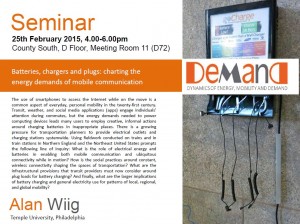 The use of smartphones to access the Internet while on the move is a common aspect of everyday, personal mobility in the twenty-first century. Transit, weather, and social media applications (apps) engage individuals’ attention during commutes, but the energy demands needed to power computing devices leads many users to employ creative, informal actions around charging batteries in inappropriate places. There is a growing pressure for transportation planners to provide electrical outlets and charging stations systemwide. Using fieldwork conducted on trains and in train stations in Northern England and the Northeast United States prompts the following line of inquiry: What is the role of electrical energy and batteries in enabling both mobile communication and ubiquitous connectivity while in motion? How is the social practices around constant, wireless connectivity shaping the spaces of transportation? What are the infrastructural provisions that transit providers must now consider around plug loads for battery charging? And finally, what are the larger implications of battery charging and general electricity use for patterns of local, regional, and global mobility?
The use of smartphones to access the Internet while on the move is a common aspect of everyday, personal mobility in the twenty-first century. Transit, weather, and social media applications (apps) engage individuals’ attention during commutes, but the energy demands needed to power computing devices leads many users to employ creative, informal actions around charging batteries in inappropriate places. There is a growing pressure for transportation planners to provide electrical outlets and charging stations systemwide. Using fieldwork conducted on trains and in train stations in Northern England and the Northeast United States prompts the following line of inquiry: What is the role of electrical energy and batteries in enabling both mobile communication and ubiquitous connectivity while in motion? How is the social practices around constant, wireless connectivity shaping the spaces of transportation? What are the infrastructural provisions that transit providers must now consider around plug loads for battery charging? And finally, what are the larger implications of battery charging and general electricity use for patterns of local, regional, and global mobility?
Understanding Demand
Influencing Demand
Policies for steering demand
Invisible energy policy
Adapting social practices
Commission on Travel Demand
How Demand Varies
Situations, Sites, Sectors
Domestic IT use
Home heating
Offices and office work
Business travel
Online shopping
Car dependence
Older people and mobile lives
Local smart grids
Cooking and cooling in Asia
Energy, Justice and Poverty

